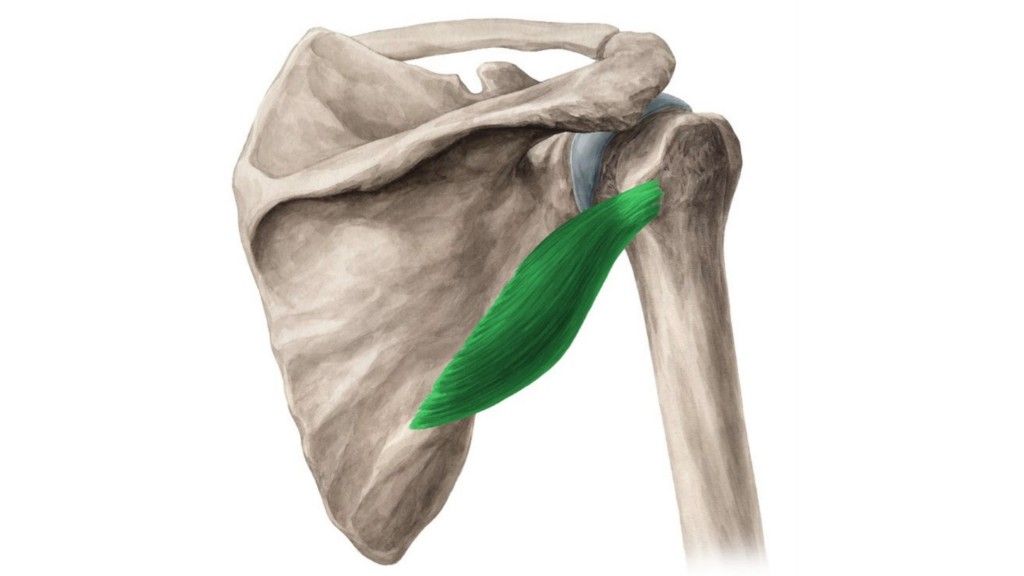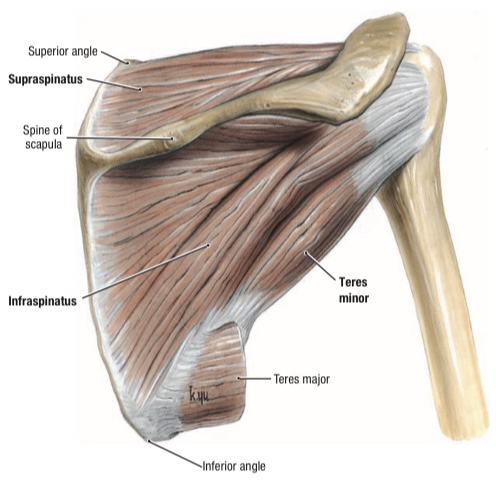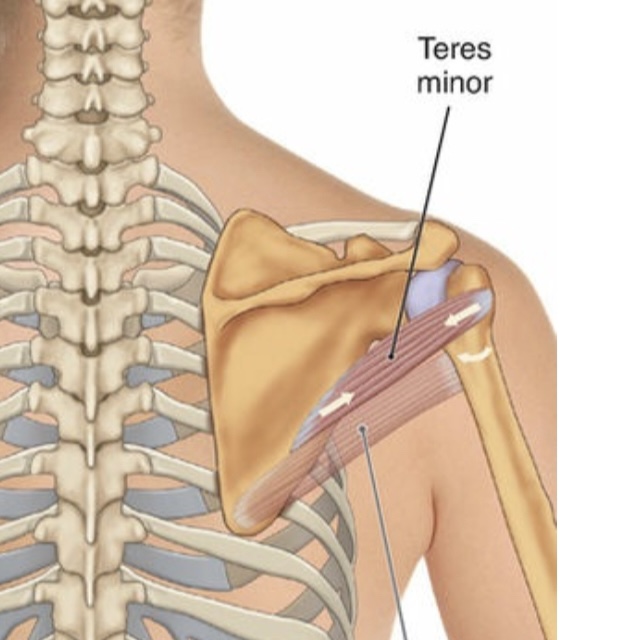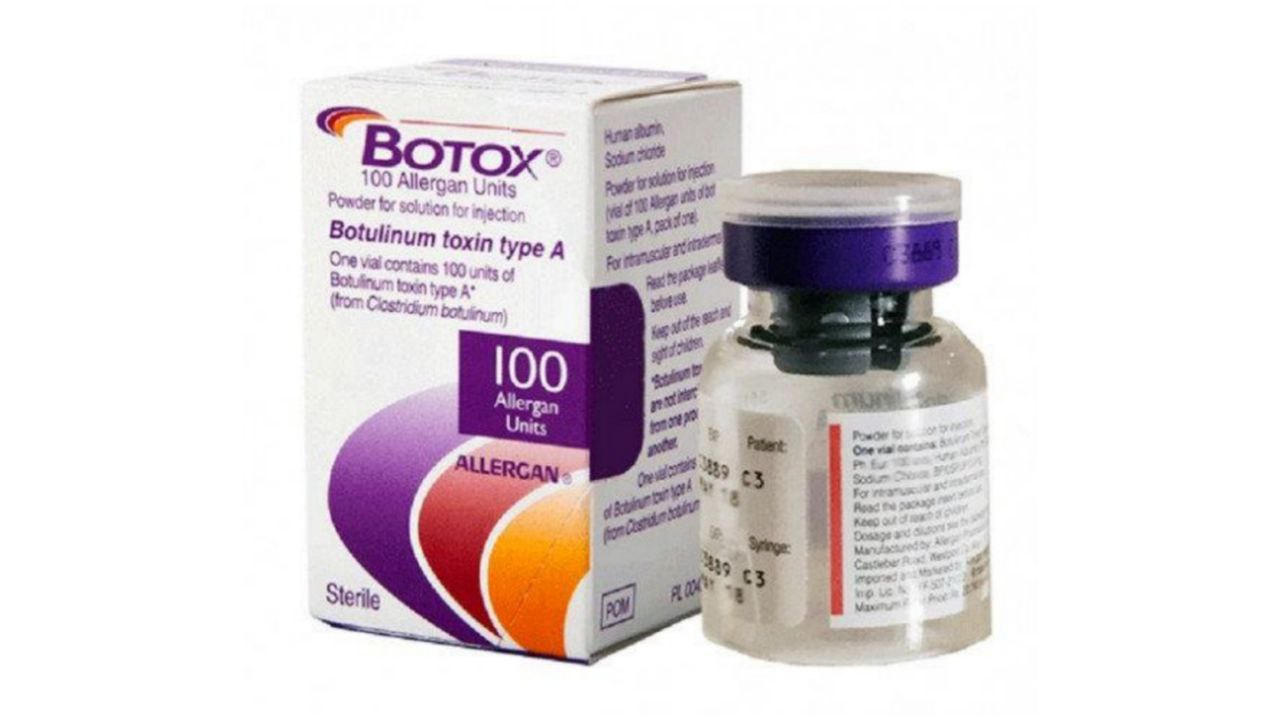
Teres Minor
By : Karam Alanaz
It is one of the rotate cuff muscles , the name of it tells us that the muscle is round and small.
General
*it is smaller than teres minor.
* ATTACHMENTS
Superior Lateral Border of the Scapula
the superior 2⁄3 of the dorsal surface, and
Greater Tubercle of the Humerus p
the inferior facet.
*it works at shoulder joint .
* ATTACHMENTS
Superior Lateral Border of the Scapula
the superior 2⁄3 of the dorsal surface, and
Greater Tubercle of the Humerus p
the inferior facet.
*it works at shoulder joint .
Supply
* ARTERIAL : The Circumflex Scapular Artery ( branch of the Subscapular Artery ) and the Posterior Circumflex Humeral Artery ( branch of the Axillary Artery )
* INNERVATION : The Axillary Nerve C5, C6
* INNERVATION : The Axillary Nerve C5, C6

Origin
Superior Lateral Border of the Scapula ,(the superior 2⁄3 of the dorsal surface)
Inserion
Greater Tubercle of the Humerus (the inferior facet)
Movement(Action)
(laterally rotates the arm at the shoulder joint
and helps to hold humeral head in glenoid cavity )
A- Standard Mover Action :
1-when the teres minor contracts and the humeral attachment is pulled toward the scapular attachment, the posterior side of the humerus moves medially. This movement is called lateral rotation of the arm at the GH joint.
2- There is some controversy regarding whether or not the teres minor can adduct the arm at the GH joint. However, the humeral attachment seems clearly distal enough for it to be below the center of the joint and therefore perform adduction.
3- When the arm is in a position of 90 degrees of abduction, the teres minor’s line of pull is horizontal and can pull the arm directly posteriorly. This motion is called horizontal extension (or horizontal abduction) of the arm at the GH joint.
B- Reverse Mover Action :
1-If the arm is fixed and the teres minor contracts, the scapula is pulled toward the humerus, causing the medial border to lift away from the rib cage wall. This motion is called lateral tilt (or medial rotation) of the scapula and occurs at the GH joint.
2- at the arm is fixed and the teres minor contracts, the inferior angle of the scapula is pulled up toward the humerus, resulting in upward rotation of the scapula at the GH joint.
3- When the scapula moves relative to the arm at the GH joint, it also moves relative to the rib cage at the scapulocostal joint .
* it helps in Stabilizer the shoulder joint and Stabilizer the scapula .
* The rotator cuff muscles (supraspinatus, infraspinatus, teres minor, and
subscapularis) are extremely important as stabilizers of the head of the humerus
at the shoulder joint.
and helps to hold humeral head in glenoid cavity )
A- Standard Mover Action :
1-when the teres minor contracts and the humeral attachment is pulled toward the scapular attachment, the posterior side of the humerus moves medially. This movement is called lateral rotation of the arm at the GH joint.
2- There is some controversy regarding whether or not the teres minor can adduct the arm at the GH joint. However, the humeral attachment seems clearly distal enough for it to be below the center of the joint and therefore perform adduction.
3- When the arm is in a position of 90 degrees of abduction, the teres minor’s line of pull is horizontal and can pull the arm directly posteriorly. This motion is called horizontal extension (or horizontal abduction) of the arm at the GH joint.
B- Reverse Mover Action :
1-If the arm is fixed and the teres minor contracts, the scapula is pulled toward the humerus, causing the medial border to lift away from the rib cage wall. This motion is called lateral tilt (or medial rotation) of the scapula and occurs at the GH joint.
2- at the arm is fixed and the teres minor contracts, the inferior angle of the scapula is pulled up toward the humerus, resulting in upward rotation of the scapula at the GH joint.
3- When the scapula moves relative to the arm at the GH joint, it also moves relative to the rib cage at the scapulocostal joint .
* it helps in Stabilizer the shoulder joint and Stabilizer the scapula .
* The rotator cuff muscles (supraspinatus, infraspinatus, teres minor, and
subscapularis) are extremely important as stabilizers of the head of the humerus
at the shoulder joint.

Relation
1-The medial portion of the teres minor is superficial and is located at the lateral border of the scapula.
2- The lateral portion of the teres minor is deep to the deltoid.
3-On the scapula the teres minor attaches just superior to the attachment of the teres major.
4-The teres minor lies between the infraspinatus (which is superior to it) and the teres major (which is inferior to it).
5-The long head of the triceps brachii runs between the teres minor and the teres major.
6- The teres minor is located within the deep back arm line myofascial meridian.
2- The lateral portion of the teres minor is deep to the deltoid.
3-On the scapula the teres minor attaches just superior to the attachment of the teres major.
4-The teres minor lies between the infraspinatus (which is superior to it) and the teres major (which is inferior to it).
5-The long head of the triceps brachii runs between the teres minor and the teres major.
6- The teres minor is located within the deep back arm line myofascial meridian.
Notes :
* The teres minor is one of three muscles that attach onto the greater tubercle of the
humerus. The other two muscles that attach here are the supraspinatus and the
infraspinatus.
* Sometimes the teres minor blends with the infraspinatus.
* The teres major and the teres minor, because of their different rotary actions of
the arm, are in different functional groups , These two muscles are also innervated by different nerves.
* The teres minor is one of three muscles that attach onto the greater tubercle of the
humerus. The other two muscles that attach here are the supraspinatus and the
infraspinatus.
* Sometimes the teres minor blends with the infraspinatus.
* The teres major and the teres minor, because of their different rotary actions of
the arm, are in different functional groups , These two muscles are also innervated by different nerves.
clinical note
HOW TO EXAMINE (PALPATION) THE TERES MINOR ?
1- With the patient prone with the arm on the table and the forearm hanging off the table, place palpating hand just lateral to the superior lateral border of the scapula and feel for the round belly of the teres minor.
2-Have the patient laterally rotate the arm at the shoulder joint (this requires the clierot’s hand to swing anteriorly and up) and feel for its contraction. Resistance can be given. (Note: It can be challenging to discern the teres minor from the infraspinatus.)
3- Palpate the teres minor distally to the greater tubercle of the humerus.
1- With the patient prone with the arm on the table and the forearm hanging off the table, place palpating hand just lateral to the superior lateral border of the scapula and feel for the round belly of the teres minor.
2-Have the patient laterally rotate the arm at the shoulder joint (this requires the clierot’s hand to swing anteriorly and up) and feel for its contraction. Resistance can be given. (Note: It can be challenging to discern the teres minor from the infraspinatus.)
3- Palpate the teres minor distally to the greater tubercle of the humerus.
